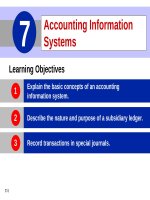Intermediate accounting volum 1 IFRS edition chapter 07
Bạn đang xem bản rút gọn của tài liệu. Xem và tải ngay bản đầy đủ của tài liệu tại đây (4.56 MB, 109 trang )
7-1
CHAPTER
7
CASH AND RECEIVABLES
Intermediate Accounting
IFRS Edition
Kieso, Weygandt, and Warfield
7-2
Learning
Learning Objectives
Objectives
7-3
1.
Identify items considered cash.
2.
Indicate how to report cash and related items.
3.
Define receivables and identify the different types of receivables.
4.
Explain accounting issues related to recognition of accounts receivable.
5.
Explain accounting issues related to valuation of accounts receivable.
6.
Explain accounting issues related to recognition of notes receivable.
7.
Explain accounting issues related to valuation of notes receivable.
8.
Understand special topics related to receivables.
9.
Describe how to report and analyze receivables.
Cash
Cash and
and Receivables
Receivables
Cash
7-4
Accounts
Receivable
Notes Receivable
Special Issues
What is cash?
Recognition
Recognition
Fair value option
Reporting cash
Valuation
Valuation
Summary of cashrelated items
Impairment
evaluation process
Derecognition of
receivables
Presentation and
analysis
Cash
Cash
What is Cash?
A financial asset—also a financial instrument.
Financial Instrument - Any contract that gives rise to a
financial asset of one entity and a financial liability or
equity interest of another entity.
Illustration 7-1
Types of
Assets
7-5
LO 1 Identify items considered cash.
Cash
Cash
What is Cash?
► Most liquid asset.
► Standard medium of exchange.
► Basis for measuring and accounting for all other items.
► Current asset.
Examples: coin, currency, available funds on deposit at the
bank, money orders, certified checks, cashier’s checks, personal
checks, bank drafts and savings accounts.
7-6
LO 1 Identify items considered cash.
Cash
Cash
Reporting Cash
Cash Equivalents
Short-term, highly liquid investments that are both
(a) readily convertible to cash, and
(b) so near their maturity that they present insignificant risk
of changes in interest rates.
Examples: Treasury bills, commercial paper, and money market
funds.
7-7
LO 2 Indicate how to report cash and related items.
Cash
Cash
Restricted Cash
When material in amount:
Segregate restricted cash from “regular” cash.
Current assets or non-current assets
Examples, restricted for: (1) plant expansion, (2) retirement of
long-term debt, and (3) compensating balances.
7-8
LO 2 Indicate how to report cash and related items.
Cash
Cash
Bank Overdrafts
When a company writes a check for more than the
amount in its cash account.
Generally reported as a current liability.
Offset against cash account only when available cash is
present in another account in the same bank on which
the overdraft occurred.
7-9
LO 2 Indicate how to report cash and related items.
Cash
Cash
Summary of Cash-Related Items
7-10
Illustration 7-3
LO 2
Accounts
Accounts Receivable
Receivable
Receivables are claims held against customers and
others for money, goods, or services.
7-11
Oral promises of the
purchaser to pay for goods
and services sold.
Written promises to pay a
sum of money on a
specified future date.
Accounts
Accounts
Receivable
Receivable
Notes
Notes
Receivable
Receivable
LO 3 Define receivables and identify the different types of receivables.
Accounts
Accounts Receivable
Receivable
Non-trade Receivables
1.
2.
3.
4.
5.
6.
Advances to officers and employees.
Advances to subsidiaries.
Deposits to cover potential damages or losses.
Deposits as a guarantee of performance or payment.
Dividends and interest receivable.
Claims against:
a)
b)
c)
d)
e)
f)
7-12
Insurance companies for casualties sustained.
Defendants under suit.
Governmental bodies for tax refunds.
Common carriers for damaged or lost goods.
Creditors for returned, damaged, or lost goods.
Customers for returnable items (crates, containers, etc.).
LO 3 Define receivables and identify the different types of receivables.
Accounts
Accounts Receivable
Receivable
Non-trade Receivables
7-13
Illustration 7-4
Receivables Statement
of Financial Position
Presentations
LO 3 Define receivables and identify the different types of receivables.
Accounts
Accounts Receivable
Receivable
Recognition of Accounts Receivable
Trade
Trade Discounts
Discounts
Reductions
Reductionsfrom
fromthe
thelist
list
price
price
Not
Notrecognized
recognizedin
inthe
the
accounting
accountingrecords
records
Customers
Customersare
arebilled
billednet
netof
of
discounts
discounts
7-14
10 %
Discount
for new
Retail
Store
Customer
s
LO 4 Explain accounting issues related to recognition of accounts receivable.
Accounts
Accounts Receivable
Receivable
Recognition of Accounts Receivable
Cash
Cash Discounts
Discounts
(Sales
(SalesDiscounts)
Discounts)
Inducements
Inducementsfor
forprompt
prompt
payment
payment
Gross
GrossMethod
Methodvs.
vs.Net
Net
Method
Method
7-15
Payment terms
are 2/10, n/30
LO 4 Explain accounting issues related to recognition of accounts receivable.
Accounts
Accounts Receivable
Receivable
Cash Discounts (Sales Discounts)
7-16
Illustration 7-5
Entries under Gross and
Net Methods of Recording
Cash (Sales) Discounts
LO 4 Explain accounting issues related to recognition of accounts receivable.
Accounts
Accounts Receivable
Receivable
E7-5: On June 3, Bolton Company sold to Arquette Company
merchandise having a sale price of £2,000 with terms of 2/10, n/60,
f.o.b. shipping point. On June 12, the company received a check for
the balance due from Arquette Company. Prepare the journal entries
on Bolton Company books to record the sale assuming Bolton
records sales using the gross method.
June 3
Accounts receivable
2,000
Sales
June 12
Cash
Sales discounts (£2,000 x 2%)
Accounts receivable
7-17
2,000
1,960
40
2,000
LO 4 Explain accounting issues related to recognition of accounts receivable.
Accounts
Accounts Receivable
Receivable
E7-5: On June 3, Bolton Company sold to Arquette Company
merchandise having a sale price of £2,000 with terms of 2/10, n/60,
f.o.b. shipping point. On June 12, the company received a check for
the balance due from Arquette Company. Prepare the journal entries
on Bolton Company books to record the sale assuming Bolton
records sales using the net method.
June 3
Accounts receivable
1,960
Sales
June 12
Cash (£2,000 x 98%)
Accounts receivable
7-18
1,960
1,960
1,960
LO 4 Explain accounting issues related to recognition of accounts receivable.
Accounts
Accounts Receivable
Receivable
E7-5: On June 3, Bolton Company sold to Arquette Company
merchandise having a sale price of £2,000 with terms of 2/10, n/60,
f.o.b. shipping point. Prepare the journal entries on Bolton Company
books to record the sale assuming Bolton records sales using the net
method, and Arquette did not remit payment until July 29.
June 3
Accounts receivable
1,960
Sales
June 12
Cash
Accounts receivable
Sales discounts forfeited
7-19
1,960
2,000
1,960
40
LO 4 Explain accounting issues related to recognition of accounts receivable.
Accounts
Accounts Receivable
Receivable
Non-Recognition of Interest Element
A company should measure receivables in terms of their
present value.
In practice, companies ignore interest revenue related to
accounts receivable because, for current assets, the
amount of the discount is
not usually material in
relation to the net income
for the period.
7-20
LO 4 Explain accounting issues related to recognition of accounts receivable.
Accounts
Accounts Receivable
Receivable
How are these accounts presented on the Statement of
Financial Position?
Accounts Receivable
7-21
Allowance for
Doubtful Accounts
Beg.
500
25
Beg.
End.
500
25
End.
LO 4 Explain accounting issues related to recognition of accounts receivable.
Accounts
Accounts Receivable
Receivable
7-22
LO 4 Explain accounting issues related to recognition of accounts receivable.
Accounts
Accounts Receivable
Receivable
7-23
LO 4 Explain accounting issues related to recognition of accounts receivable.
Accounts
Accounts Receivable
Receivable
Journal entry for credit sale of $100?
Accounts receivable
Sales
Accounts Receivable
7-24
100
100
Allowance for
Doubtful Accounts
Beg.
500
25
Beg.
End.
500
25
End.
LO 4 Explain accounting issues related to recognition of accounts receivable.
Accounts
Accounts Receivable
Receivable
Journal entry for credit sale of $100?
Accounts receivable
Sales
Accounts Receivable
7-25
Beg.
500
Sale
100
End.
600
100
100
Allowance for
Doubtful Accounts
25
Beg.
25
End.
LO 4 Explain accounting issues related to recognition of accounts receivable.









